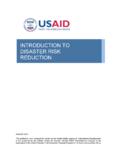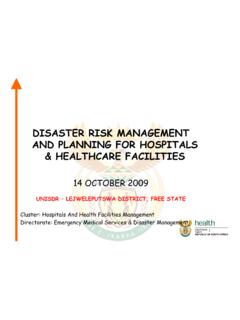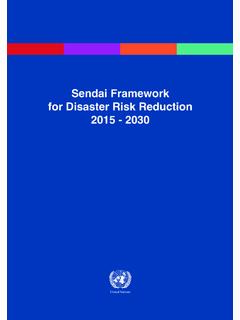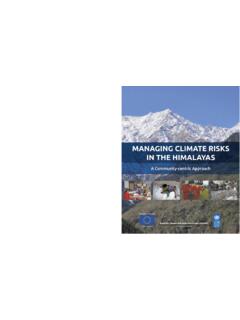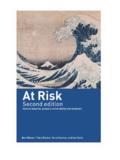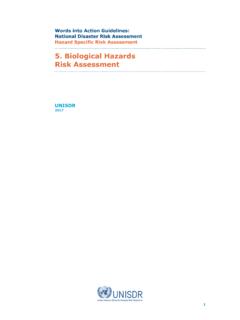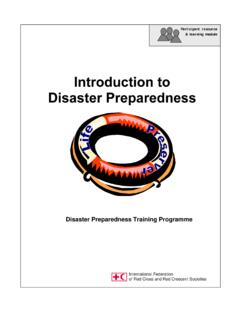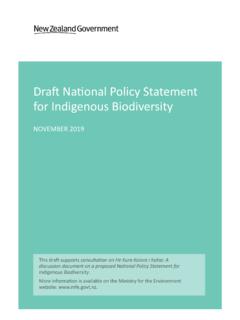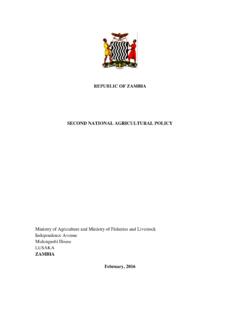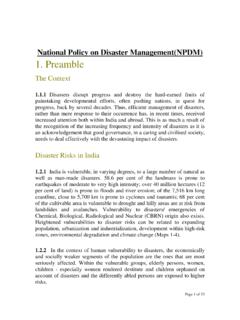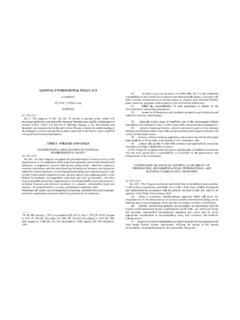Transcription of National Environmental Policy and Strategies
1 National Environmental Policy and Strategies 2 1. The Need for a National Policy on the Environment Sri Lanka s landscape, vegetation and climate, and its people, had once blended to form an island of incredible beauty and serenity, and the country was called Serendip. Much of this has changed over the past few centuries, particularly in the past few decades. It is the people that have brought about these changes. Sri Lanka s population, now reaching 19 million, places the island among the most densely populated countries in the world, and a good proportion of the population live in poverty. These are the most potent underlying factors that have brought about the changes in Sri Lanka s environment, threatening to undermine the nation s natural resource base. The nation s effort to advance its pace of development, while maintaining the essential freedom of the people to make choices, has had adverse impacts on the four primary natural resources, the land , water, atmosphere and living resources, and on the living environment.
2 While recognizing the imperative of socio-economic development in addressing the underlying causes of Environmental degradation, there has been, in recent years, a growing realization that uninhibited development, while it may yield immediate benefits, will undermine the development process by causing irreparable damage to the natural resources that support development. Optimizing development, and therefore maintaining its sustainability, will only be possible by safeguarding the environment through protecting nature and its life support systems. Legal, Policy , and institutional interventions aimed at addressing Environmental issues have been made since the 1980s. National Environmental Action Plans have been in place since 1992, and various measures aimed at controlling Environmental degradation have been adopted in the different sectors. These actions, however, fell far short of what is required for ensuring that the development process remains sustainable and that Environmental integrity is maintained.
3 This underscored the need for a National Policy on the environment; a Policy that will bind all organisations and individuals who use Environmental resources or otherwise have an impact on the resources to exercise due care to avoid Environmental degradation. Such a Policy , in its implementation, will pave the way for sustainable development. This is the basis on which the National Environmental Policy has been formulated. 2. The National Environmental Policy The Constitution of Sri Lanka makes it The duty of every person in Sri Lanka to protect nature and conserve its riches . The National Environmental Policy acknowledges this duty and seeks to provide the direction according to which steps will be taken to conserve and manage Sri Lanka s environment in all its aspects. The National Environmental Policy renews the commitment of government, in partnership with the people, effectively to manage the environment for the benefit of present and future generations.
4 The aim of this Policy is to ensure sound Environmental management within a framework of sustainable development in Sri Lanka. This Policy is supported by many other policies and Strategies developed for other sectors. The National Environmental Policy emphasizes that caring for the environment is the bounden duty of any institution, government or non-government, and of any individual that uses, or otherwise carries out an activity that has an impact on, the resources of the environment. Technical terms used in the text are explained in the Annex. 3 Objectives 1. To promote the sound management of Sri Lanka s environment in its entirety without compromise, balancing the needs for social and economic development and Environmental integrity, to the maximum extent possible while restricting inimical activities. 2. To manage the environment by linking together the activities, interests and perspectives of all groups, including the people, non-government organizations and government at both the central and the local levels.
5 3. To assure Environmental accountability. Principles 1. The guiding principles of Environmental management will be the polluter pays and the need to reduce consumption, and recycle and reuse materials to the maximum extent possible. 2. When living natural resources are used, it will be ensured that such use is wise, sustainable, and consistent with the integrity of ecosystems and evolutionary processes. 3. When non-living resources are used, it will be ensured that such use is consistent with Environmental best-practice, bearing in mind the need to provide also for future generations. 4. Traditional knowledge and practices will be respected in the development of Environmental management systems. 5. Effective governance will be ensured through the decentralization of Environmental management services to the maximum possible extent. Statements 1. Resources such as land , water, air, minerals and biodiversity will be managed in a manner consistent with the viability of ecological processes.
6 2. Environmental management will be through participatory, transparent, predictable and accountable decision-making processes at all levels. 3. In addition to protecting the environment from abuse, management systems will take into account the need to restore environments damaged in the past. 4. Environmental management systems will be encouraged to be flexible so as to adapt to changing situations ( climate change, invasive species and living genetically-modified organisms) and adopt the Precautionary Principle. 5. The economic value of Environmental services will be recognized so as to assure the sustainability of such services for the benefit of the people. 6. The state of the environment will continuously be assessed and reported on through an appropriate institutionalized monitoring framework based on a comprehensive set of indicators. 7. The institutional framework for sound Environmental management will be strengthened through capacity-building, legislative instruments and improved inter-institutional coordination and linkages.
7 8. Life cycle and 'cleaner production' principles will be applied to improve the efficiency of natural resource use and to improve Environmental quality. 4 9. Responsible public-private and community partnerships and linkages will be promoted at all levels of Environmental management and conservation. 10. Education at all levels, together with research, will be promoted in a manner designed to increase the level of awareness of all aspects of the environment and its care and management among all stakeholders. 11. Socially responsible behaviours will be encouraged and further developed through an effective framework of awareness building, incentives and enforcement. 12. International commitments will be honoured as part of our responsibility to the National and global communities. Annex : Explanation of Key Concepts Biodiversity The total variety and variability of all living things, including their genetic constituents, interrelationships and habitats; and the ecosystems and landscapes of which they are part.
8 Cleaner production The continuous application of an integrated preventive strategy to processes, products and services so as to increase efficiency and reduce risks to people and the environment. Climate change The human-induced changes taking place in the world s climate, especially the trend towards global warming, which will deeply impact on ecosystems. The UN Framework Convention on Climate Change and its Kyoto Protocol seek to reduce the rate of change by curbing practices that are thought to accelerate climate change. Conservation The wise use and management of nature and natural resources for their inherent value and for the benefit of society, bearing in mind that future generations have as much right to these resources as our own [see also Protection]. Ecological process A process involving the relationship between an organism and (both the living and non-living elements of) its environment.
9 Wise conservation practice should not be restricted to organisms by themselves but be extended also to the 5 ecological processes of which they are part. Ecosystem A complex of living communities of organisms and their non-living environment interacting as an entity of its own. Environment The ecosystem of which we are part. Environmental indicators Direct or indirect signs that inform us about the health or sickness of the environment. Examples include lichens, which die in the presence of pollutant gases; and the presence of the bacterium E. coli in water, which suggests the presence of faecal matter. Environmental integrity The wholeness of our environment, without any aspect of it being damaged. Environmental The principle that we are each accountable for accountability any actions on our part that affect the environment, and acknowledges our accountability to society. Evolutionary processes The complex processes giving rise to the evolution of organisms, usually involving observable changes only after thousands or millions of years.
10 Biodiversity conservation is about the conservation of evolutionary processes: we seek to conserve not just species and their ecosystems, but their freedom to continue the process of evolution in perpetuity. In view of the pressures on ecosystems resulting from human-induced disturbances such as pollution, habitat degradation and invasive species, evolutionary processes are threatened in the truly long term. Invasive species Species not indigenous to a given ecosystem, but which invade it, usually as a result of introduction from abroad ( the widespread tilapia fish, which was introduced from Africa in the 1950s). Indigenous species too, can invade ecosystems that are damaged or under stress. Life Cycle Principle Designing, producing and using goods and services so as to minimize negative impacts on people and ecosystems, whether in the short- or long-term.

